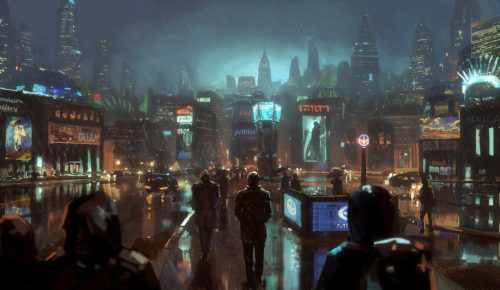
It’s now 33 years since Neuromancer was published – establishing the cyberpunk timeframe as near-future – and that’s as long as either Alexander the Great or Jesus had in this world. It’s long enough for this essay to look back from the vantage point of 2017 and see how cyberpunk Planet Earth ended up becoming in this timeline.
Where Neuromancer and Snow Crash were half right was in their prediction of a matrix within cyberspace that filled the human need for societal interaction. FaceBook and the other giants of social media certainly led the ordinary citizens of meatspace to spend a lot more time in cyberspace, but we are still limited to the bulletin board model.
Advancements in virtual reality technology have been limited, to a large part, by the need for extreme amounts of processing power. A VR setup must be capable of generating a sufficient rate of frames per second to avoid latency from the perspective of the user, because this leads to simulator sickness, which decreases the level of telepresence.
So nothing really like the eponymous all-encompassing virtual environment in The Matrix, or the metaverse, has yet arisen.
Where all of the cyberpunk classics got it right was in the widespread adoption of novel classes of synthetic drugs.
Humans have always loved to experiment with consciousness – use of magic mushrooms, cannabis and alcohol all predate the use of writing. So it was fairly predictable that new advances in chemistry would lead to new frontiers in the exploration of mental space.
Although most of the chemical enhancement in cyberpunk literature has been for the purposes of increasing martial aptitude, as in Lucifer’s Dragon, most of its use in consensual reality has been psychonautic. In other words, here on Earth people mostly use the new waves of drugs to get high – but that doesn’t make for very good fiction.
Blade Runner didn’t foresee much different in the way of human drug consumption, but it did anticipate how close artificial intelligence came to passing the Turing Test. Many people chat with bots on social media without even knowing it – especially in online poker rooms and on large politics pages.
Certainly this film, based on Philip K Dick’s Do Androids Dream Of Electric Sheep?, accurately captured the uneasiness of being a human and dealing with something that appears entirely human but for subtle differences.
Where the classics tended to get it wrong was politically, especially the diminished role of territorial governments. There seemed to be a glib assumption, perhaps expressed in extremis in Snow Crash, that corporations and the influence of corporations would expand to the point where 20th century-style governments no longer held any power.
In reality, hard iron laws like “political power grows out of the barrel of a gun” continue to hold true, and any government capable of raising sufficient taxation to raise an army or secret police will still be a force on the world stage.
In the world of soft power, Transmetropolitan correctly predicted that the political landscape would be as shallow and insane as ever. The absurdity of the various political candidates in Spider Jerusalem’s life are an eerily accurate foretelling of the rise of the Donald Trump/Hillary Clinton circus.
Corporations have started implanting microchips in their employees, which has been a staple of cyberpunk horror for a long time. My own The Verity Key, however, predicted a different path of adoption for microchips under the skin: I figured that people, especially the technophilic, would adopt it themselves for increased access to private space.
It remains to be seen if this will happen – the expense involved in reaching a sustainable critical mass might make private adoption of RFID networks unworkable.
Things didn’t really get as dark and dystopic as cyberpunk predicted. This was always the probable outcome for a literary genre that consciously adopted elements of horror from other genres and from film noir. Things really just became weird. Perhaps the most accurate of all – predicting the current obsession with transgenderism – was Joe Haldeman’s The Forever War.
If there are new avenues of cyberpunk still to be explored, it’s possible that they will feature characters who are unrepentant rebels with regard to questions of cognitive freedom, in particular characters pushed underground by new technologies that make intrusion into the mind possible.
That’s one way in which the brilliant anime series Psycho-Pass blazes a new path: from the harder, engineering and physics based sciences towards the biological ones. Much like The Verity Key, the Psycho-Pass series raises the question of what life will look like when neuropsychological technology advances to the point where the private thoughts of every individual have become a public matter.
The controllers of the mindreading technology in Psycho-Pass are public entities (or at least government ones), which makes for an oppressive totalitarian atmosphere, as opposed to the nihilistic anarchy of The Verity Key. Probably this timeline became more nihilistic than totalitarian, but who knows what might still happen?
With news that remote-controlled drones and tank-like war machines running off AI might soon become cheap enough for terrorists or rogue states to use every day against enemy targets, the most cyberpunk elements of human history, fictional or otherwise, may be still to come.
*
Vince McLeod is the author of cyberpunk novel The Verity Key and of the upcoming cyberpunk novel The Man With A Thousand Fathers, to be serialised here starting from the summer of 2018.
